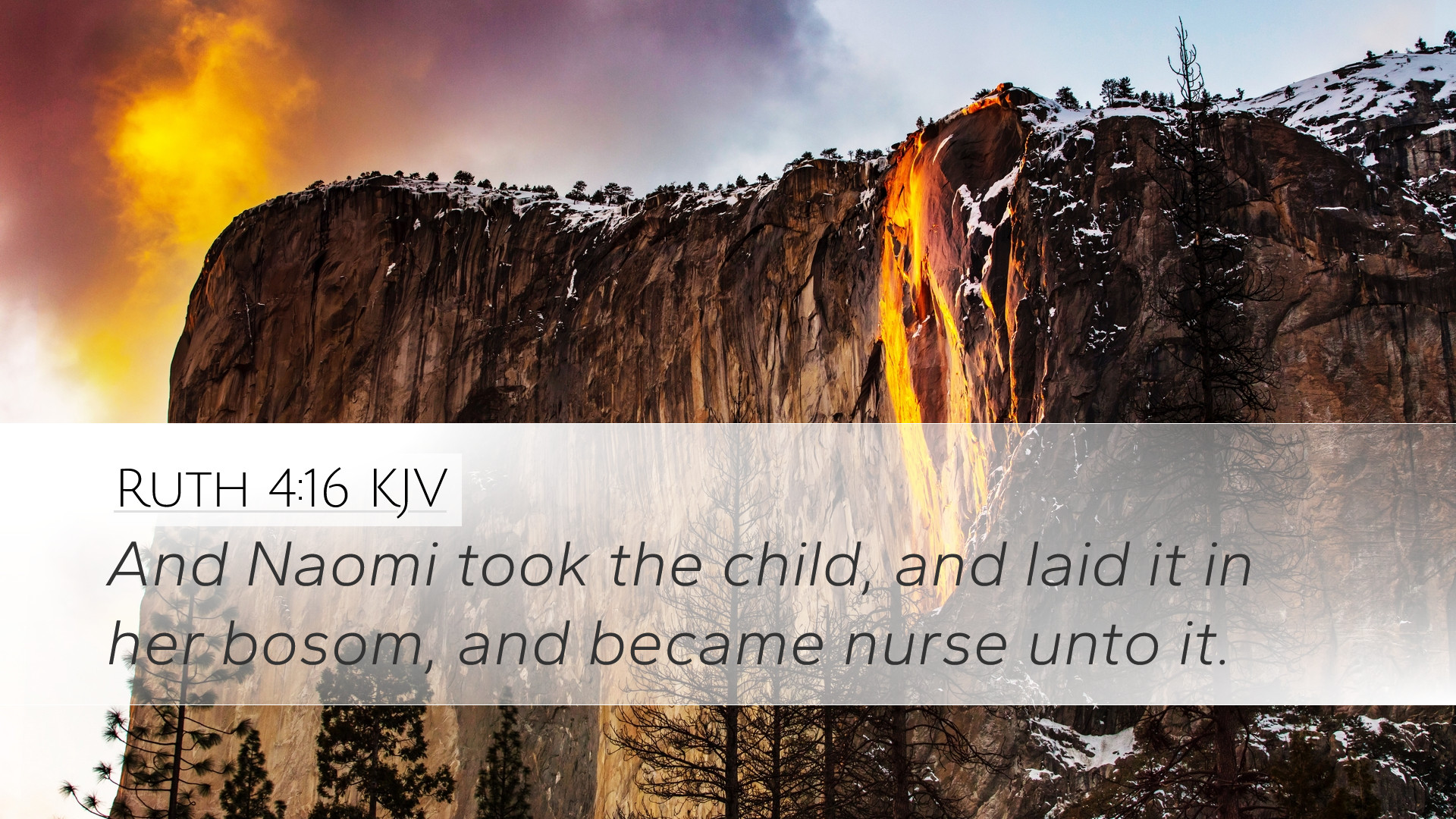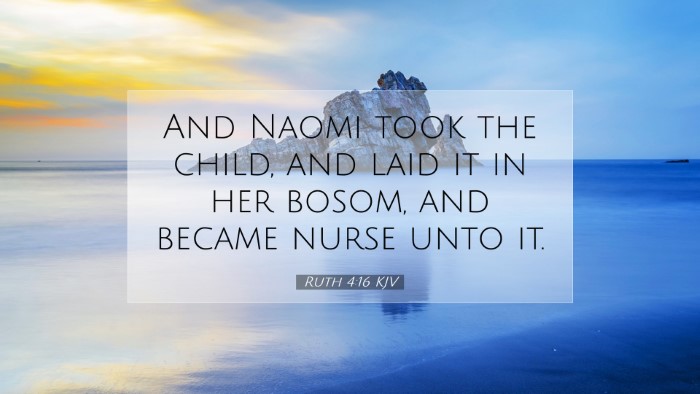Old Testament
Genesis Exodus Leviticus Numbers Deuteronomy Joshua Judges Ruth 1 Samuel 2 Samuel 1 Kings 2 Kings 1 Chronicles 2 Chronicles Ezra Nehemiah Esther Job Psalms Proverbs Ecclesiastes Song of Solomon Isaiah Jeremiah Lamentations Ezekiel Daniel Hosea Joel Amos Obadiah Jonah Micah Nahum Habakkuk Zephaniah Haggai Zechariah MalachiRuth 4:16
Ruth 4:16 KJV
And Naomi took the child, and laid it in her bosom, and became nurse unto it.
Ruth 4:16 Bible Commentary
Commentary on Ruth 4:16
Ruth 4:16 states, "And Naomi took the child, and laid it in her bosom, and became nurse unto it."
Introduction
The book of Ruth concludes with a beautiful illustration of redemption, loyalty, and God's providence. Naomi, having suffered great loss, now experiences joy with the birth of Obed through Ruth and Boaz. This verse serves as a pivotal point, emphasizing the restoration of Naomi's fortunes and the continuation of the lineage that will lead to David and ultimately to the Messiah.
Contextual Analysis
Understanding the context of Ruth 4:16 requires an appreciation of the preceding events. Naomi, who had faced tragedy—loss of her husband and sons—returns to Bethlehem filled with bitterness. However, God’s design unfolds through Ruth's loyalty and Boaz’s kindness. By the end of the narrative, Naomi’s sorrow transforms into joy as she nurses the child Obed.
Insights from Commentaries
Matthew Henry
Matthew Henry emphasizes that Naomi’s acceptance of Obed as her grandson represents the fullness of her redemption. He notes that “the child symbolizes a revival of family hope and the restoration of God’s blessings.” Henry sees Naomi’s role as a nurse not merely as a physical caretaker but as a symbolic representation of the nurturing role God fulfills in our lives, akin to the care He provides His people. He highlights the transformation from bitterness to sweetness, observing that the chapter illustrates divine providence in restoring what was lost.
Albert Barnes
Albert Barnes focuses on the deep relational dynamics of Naomi and Ruth. He notes that Naomi’s action in taking Obed into her arms signifies “the caring bond that is established through familial ties.” Barnes sees these actions as profoundly significant; they reflect the completion of Naomi’s journey from emptiness to fullness. Furthermore, he remarks on Obed’s role in their lineage as critical, proclaiming that “through this child, God’s plans for Israel will be fulfilled, linking directly to the lineage of King David.” This connection underscores the idea that God’s redemptive work extends beyond individual lives to the nation of Israel.
Adam Clarke
Adam Clarke with his analytical approach defines Naomi’s act in a different light, suggesting that “in her old age, to suckle a child gave her a purpose.” He highlights the cultural implications here, where a nurse played a significant part in nurturing children in ancient Israel. Clarke observes that Naomi’s fulfillment in this role illustrates God’s gracious restoration of her dignity and standing in the community. He posits that “this act marked the renewal of Naomi's joy and the re-establishment of her home.” Clarke’s insight brings attention to the communal aspect of care and the shared responsibilities in raising children, which was significant in ancient societies.
Theological Implications
The verse offers profound theological insights. It reflects themes of redemption, community, and God's sovereign plan. The act of Naomi nursing Obed signifies the intertwining of personal and communal restoration. It illustrates the reality that God works within and through relationships to achieve His divine purposes.
Theologically, Ruth 4:16 reminds us of God’s faithfulness in difficult times. Much like Naomi, believers may find themselves in seasons of despair but can experience a metamorphosis by faith and acceptance, leading to new beginnings.
Reflection for Pastors and Scholars
This verse calls for reflection on the roles of nurturance, care, and guidance within the church community. Pastors and theologians might consider how they can foster nurturing relationships that allow for growth and redemption in their congregations. The acknowledgment of Naomi's joy in her old age can inspire churches to create spaces where older generations are valued and where their wisdom can guide the young.
- Community Care: Emphasizes the need for inter-generational relationships where wisdom and nurture flow in both directions.
- Redemption Narratives: How the church can tell its story of redemption, echoing the transformation seen in Naomi's journey.
- The Role of Women: Highlights the significant yet often underappreciated roles women play in the life of the church, akin to Ruth and Naomi.
Conclusion
Ruth 4:16 serves as a poignant reminder of the hope that God provides even in the bleakest of circumstances. Through the lens of Naomi's experience, we understand that our stories are part of a larger narrative woven by God's hand. As we reflect on Scripture, let us remain open to God's healing and restorative work in our lives and the lives of our communities.


